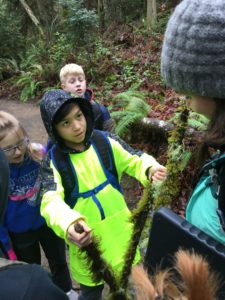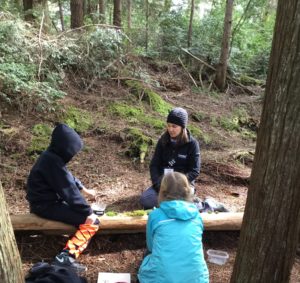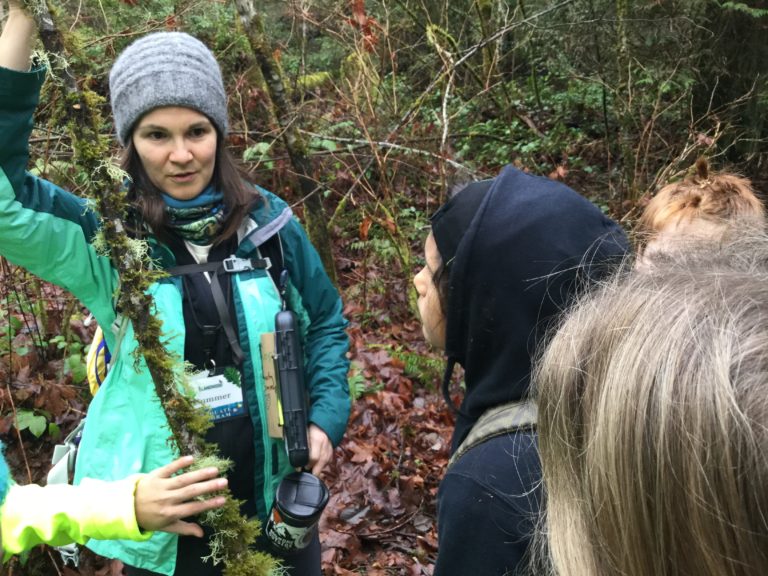Why Bryophytes?
These primitive plants are pioneers! They help colonize barren surfaces which can help create soil and reduce erosion. They contribute to the water cycle by absorbing water and slowly releasing it. They regulate nutrient cycling by altering pH and absorbing carbon. They are pollution intolerant since they absorb directly through their thallus (body) without a filtration system and are therefore an indicator of local environmental health.

Plus these modest green beauties humbly provide the wonderful green backdrop that all the other flora and wildlife enjoy. Get up close and investigate these miniature marvels!
For all of these reasons, I chose to write a poem about bryophytes after conducting an ecology investigation. In presenting my investigation findings, I also shared my poem and received overwhelming encouragement and support from my colleagues to develop it further. With some extra support from my fellow environmental educator, Amy Compare, this poem got transformed into a song!
As a knowledgable practitioner, I am leveraging my prior ecology knowledge about plant physiology and combining this with experiential education. This lesson kinestetically engages students with the bryophytes abundant in the Pacific Northwest and helps to reveal the complex connections between these humble organisms and the larger ecosystem.
My hope is to inspire further stewardship by demystifying that “wall of green” we see outside covering those rocks and tree trunks, and help pull back the curtain on an incredibly complex and fascinating ecosystem that deserves our respect and even love. This song is my ode to those lovely and humble bryophytes.
Vocabulary within song:
- Bryophyte – primitive plants with different physical structures than most macroflora, specifically they are nonvascular, small, herbaceous (nonwoody plants) plants; they ground-hugging plants and are only a few cells thick (too thin to support a tall plant, see nonvascular)
- “bryo” = moss, “phyte” = plant
- bryophytes today are represented by three phyla: mosses (Bryophyta), liverworts (Hepatophyta) and hornworts (Anthocerophyta)
- Relevance: they are pioneers in succession helping to prepare landscapes for more advanced flora, also animals live in or eat bryophytes
- rhizoids – root-like structure that provides anchorage to a substrate, not a true root; not a conducting tissue (absorption not its primary role)
- nonvascular – contributes to their small stature, lacking an internal vascular system of larger plants means that they cannot pump water or nutrients long distances; instead water absorption occurs through surface; this is an evolutionarily earlier structure than macroflora which have a vascular system
- spore – structure resulting from fertilization akin to fruits of flowering plants, however spores are more fragile structures, relying on wind or water for distribution and cannot travel long distances (a few inches at most); similar to spores produced by ferns and fungus; if a spore lands in an appropriate spot it will germinate; this is an evolutionarily earlier reproduction method than flowering plants
Consider bringing in visual aids (if able to collect in stewardly fashion) – moss on rocks or bark and/or sword fern with visible spores – this can help audience members to visually recognize spores and rhizoids in particular
This video shows the very first time that this Bryophyte Song was introduced to students. The mini lesson before the song introduces students to new vocabulary to help increase engagement. (Note that I mistakenly referred to rhizomes instead of rhizoids as the anchorage system) The chorus of the song is then introduced in a repeat-after-me style. After this introduction, Amy and I sing the entire song while inviting the audience to join in for the chorus.
Bryophyte Song
by Summer Swallow and Amy Compare
Bryophytes, see them everywhere
Bryophytes, some even look like hair
Bryophytes, just look left and right
Bryophytes, stop and feel their might
What’s a bryophyte anyway?
At IslandWood you see them when you play
They’re mosses, hornworts and liverworts
They’re green and small and often short
How are they different than plants?
They don’t have roots. They’re short in stance.
Their rhizoids hold them in their place
Anchoring them on a rock face
Bryophytes, see them everywhere
Bryophytes, some even look like hair
Bryophytes, just look left and right
Bryophytes, stop and feel their might
Nonvascular is what they are
Water in their body doesn’t go far
Soaking up water from everywhere
Even during seasons when rain is rare
No flowers, no seeds to reproduce
But you can be sure they don’t have an excuse
You may not believe it, they spread by spore
Bryophytes everywhere, Look! There’s more!
Bryophytes, see them everywhere
Bryophytes, some even look like hair
Bryophytes, just look left and right
Bryophytes, stop and feel their might


I loved reading this blog post! Your passion for bryophytes really comes through in your writing 🙂